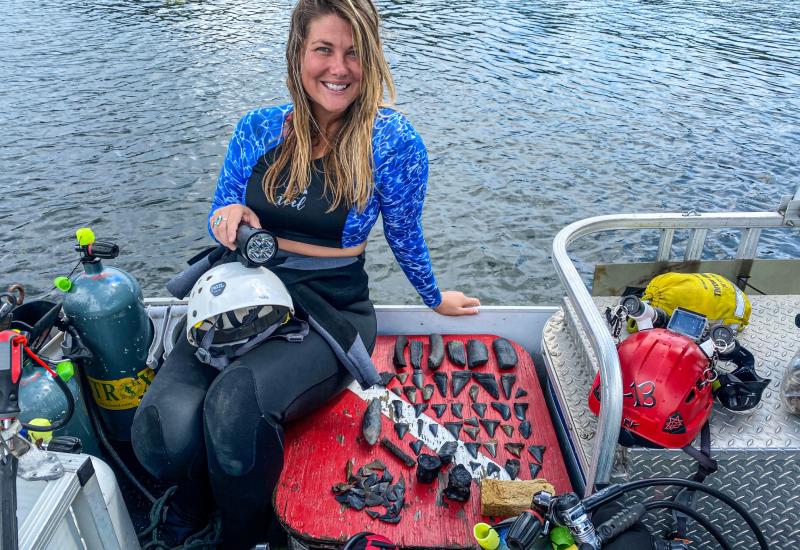What It's Like to Fossil Dive in South Carolina
There’s a gentle mist rolling off the surface of the water as the rising sun turns the sky bright orange all around. I gaze out at the banks of the Cooper River in Pimlico, South Carolina from Captain Mark’s backyard as some of the other divers load their gear onto the boat. This tidal river runs from Moncks Corner down to Charleston, taking many twists and turns as it winds through miles of cattails, cordgrass and bulrush that make up the salt marsh habitat.
It’s a peaceful morning and my mind drifts off, wondering how this serene marsh looked to the early inhabitants of the area, the First People of South Carolina’s Lowcountry from several different Tribes.
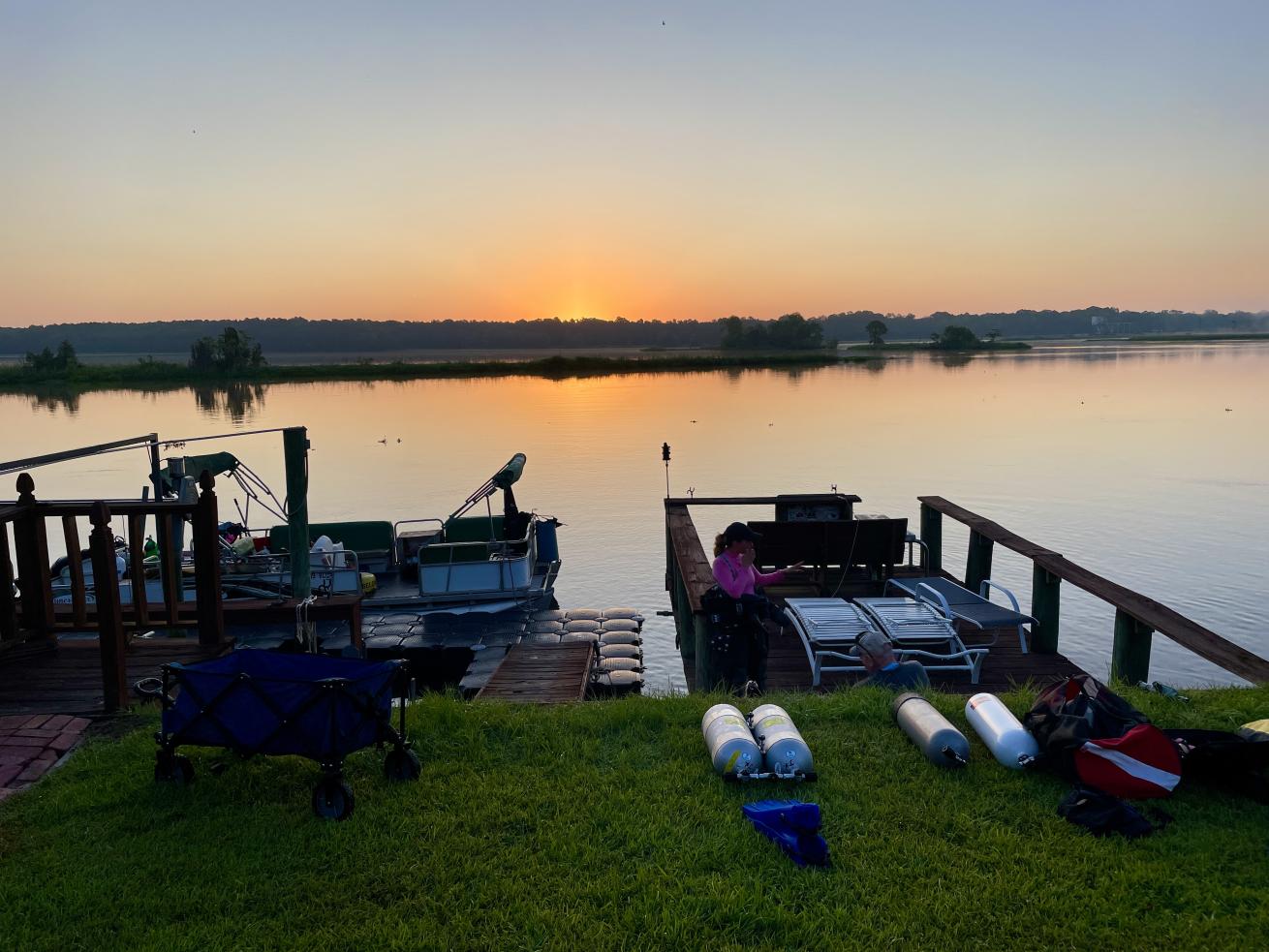
Courtesy Rachel PlunkettSunrise over the Cooper River in Pimlico, SC as divers get ready to head out.
Mark calls us over and passes around some fossils from his personal collection—a 4-inch megalodon shark tooth, fossilized clams and mussels, fish ear bones (otoliths), whale ribs and even a clay pipe from the 1700s. These incredible artifacts give me a taste of all that I can now collect during my dives in the Cooper River with my newly obtained Hobby License from the Maritime Research Division of the South Carolina Institute for Archaeology and Anthropology.
“I want to make sure you all know what you’re looking for out there,” explains Mark, “the water is dark so it helps to have an idea of what a rock versus a fossil looks and feels like before you get going.”
Related Reading: Best Destinations for Advanced Diving
Mark is a fossil-hunting expert and a loyal caretaker of these waters—he’s been navigating and diving in the Cooper River for 20 years. In that time, he has shared his enthusiasm, knowledge and exploration skills with scuba divers from around the world, responsibly discovering pieces of local history.
Winding down the river in a 24-foot pontoon, Mark points out several historical places like stretches of marsh that were once rice fields and an old rice mill that doubled as a jail cell during the Civil War. We even spot some dolphins, ospreys, and gators along the way.
My First Megalodon Tooth
We gear up at the first dive site and I thankfully remember to turn on my headlamp and wrist-mounted lights at the last minute before getting in the water. The waters here are dark and murky, with only 1-5 feet of visibility on most days. I’m diving with Ischa Vingle, a PADI Master Scuba Dive Trainer and dive shop owner from Asheville, North Carolina, who somehow convinced me (a mostly tropical diver) to venture into the murky waters of the Cooper River.
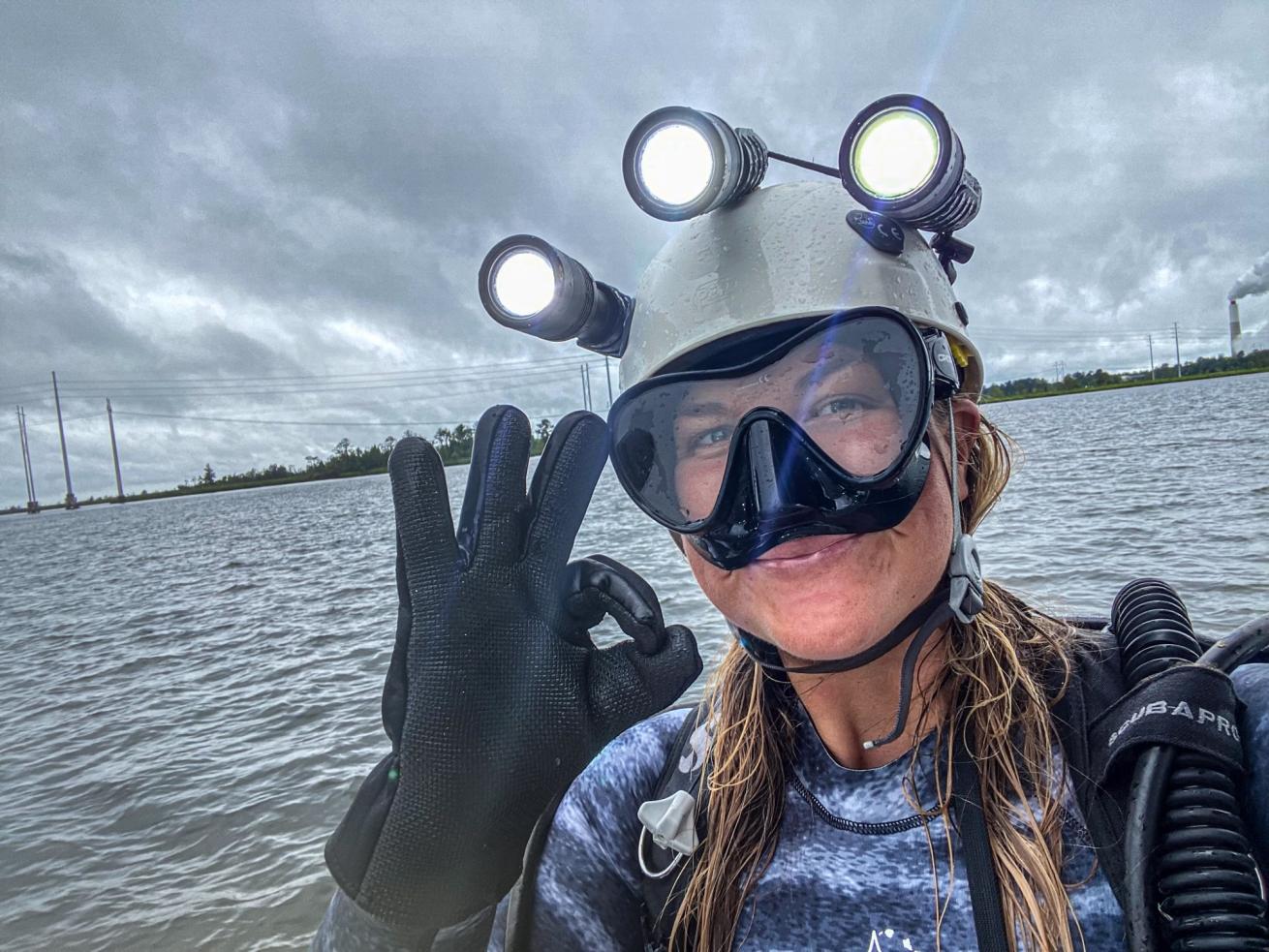
Courtesy Ischa VingleSeveral dive lights are necessary to look for fossils in the Cooper River.
As we descend the anchor line, the reality of the darkness sets in and I feel my nerves kick into overdrive. I completely lose sight of Ischa during the descent while passing through a layer of reddish and then dark brown water, until we hit bottom and I am relieved to faintly see her helmet light, though she is just 2 feet in front of me. I take a moment to gather myself and lower my heart rate, breathing steadily, before following my compass heading along the sandy and muddy bottom until I finally reach the distinct gravel pit.
The current cranks through the tidally-influenced river, and at times there’s a lot of suspended debris flying by, so I use a long screwdriver tool to steady myself. Searching the gravel pit for fossils and artifacts, I’m easily distracted by some small white shrimp and crabs living among the rocky rubble. Then I finally notice something—a triangle-shaped object with a bit of a shine to it. I pick it up and sure enough, I find my first shark tooth! The angustidens tooth is about one inch long, and it’s broken in half, but now I can be certain I’m in the right spot.
My uncertainty shifts to excitement and my mind stops thinking how dark and scary the water is and the intrusive thoughts like “what if I bump into a gator?” finally subside. About to abandon this gravel pit and search for another, I spot something big. A 3-inch megalodon tooth is sitting flat on the rocks, almost as if someone had placed it there, waiting for my discovery. I yell with glee and celebrate with myself underwater, picking up the big tooth, hugging it to my chest excitedly before putting it in my collection bag. I checked several times throughout the rest of our dive making sure it was safe and secure!
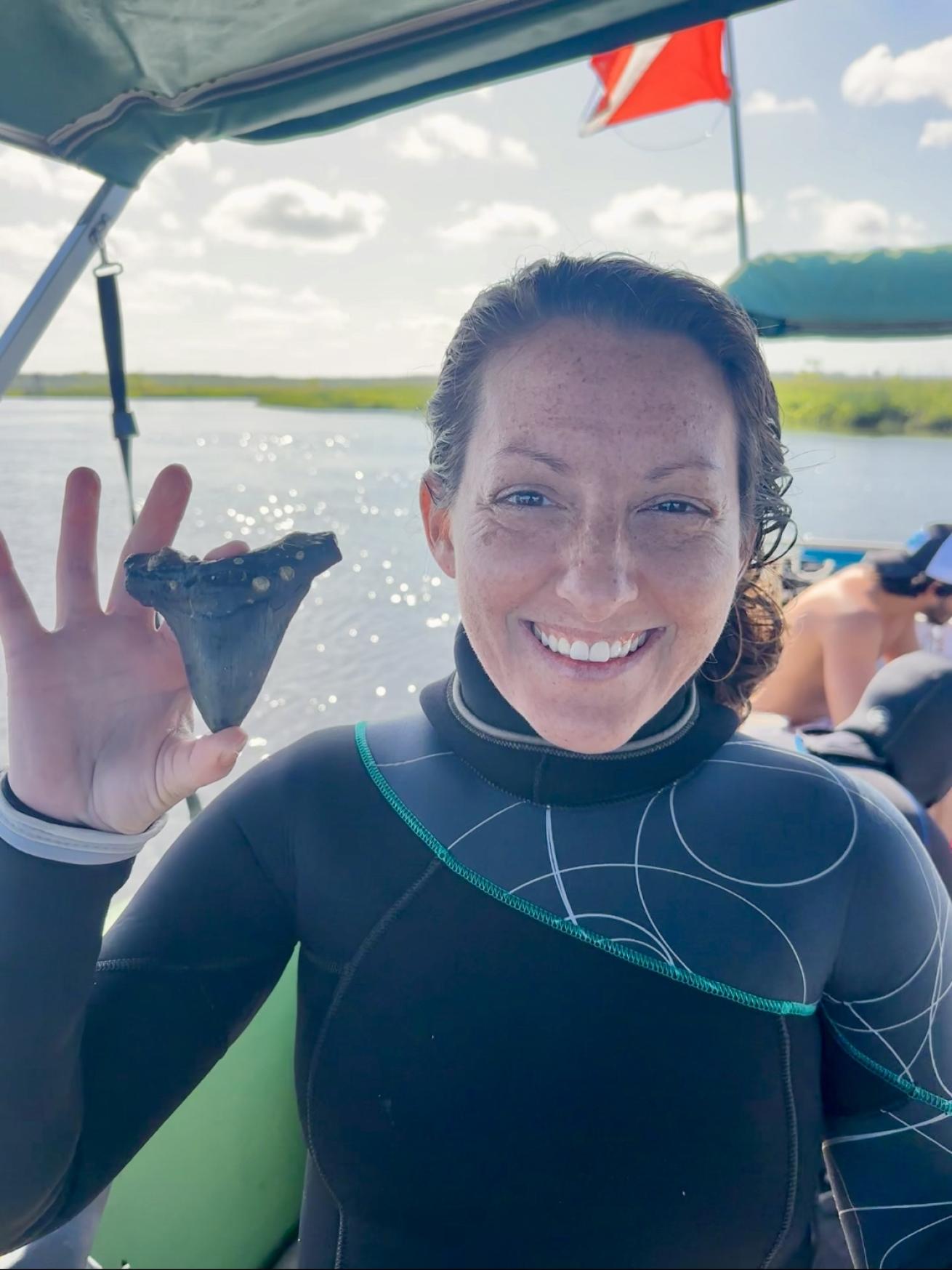
Courtesy Ischa VingleThe author with her first-ever megalodon tooth found in the Cooper River.
Back on the boat the rest of the divers gather for a show-and-tell of our discoveries. One diver found a tooth even bigger than mine, while Ischa and another diver had big piles of beautiful shark teeth in front of them. After many dives in the Cooper River, they have trained their eyes to quickly spot shark teeth among the rubble, a skill I am just beginning to master.
Not All Dives Are Created Equal
On my first dive we were able to find the gravel beds right away and start fossil hunting, but on the second dive, I spend nearly 15 minutes crawling around on the bottom searching for a gravel bed. I run straight into a big log and my heart rate spikes—I am certain I have run into an alligator. No gator, phew, but my big reaction indicates that I am not in a good mindset, so I end this dive early and save my energy for the next one. I take a few minutes to regulate my breathing, deploy my surface marker buoy, and head back to the boat.
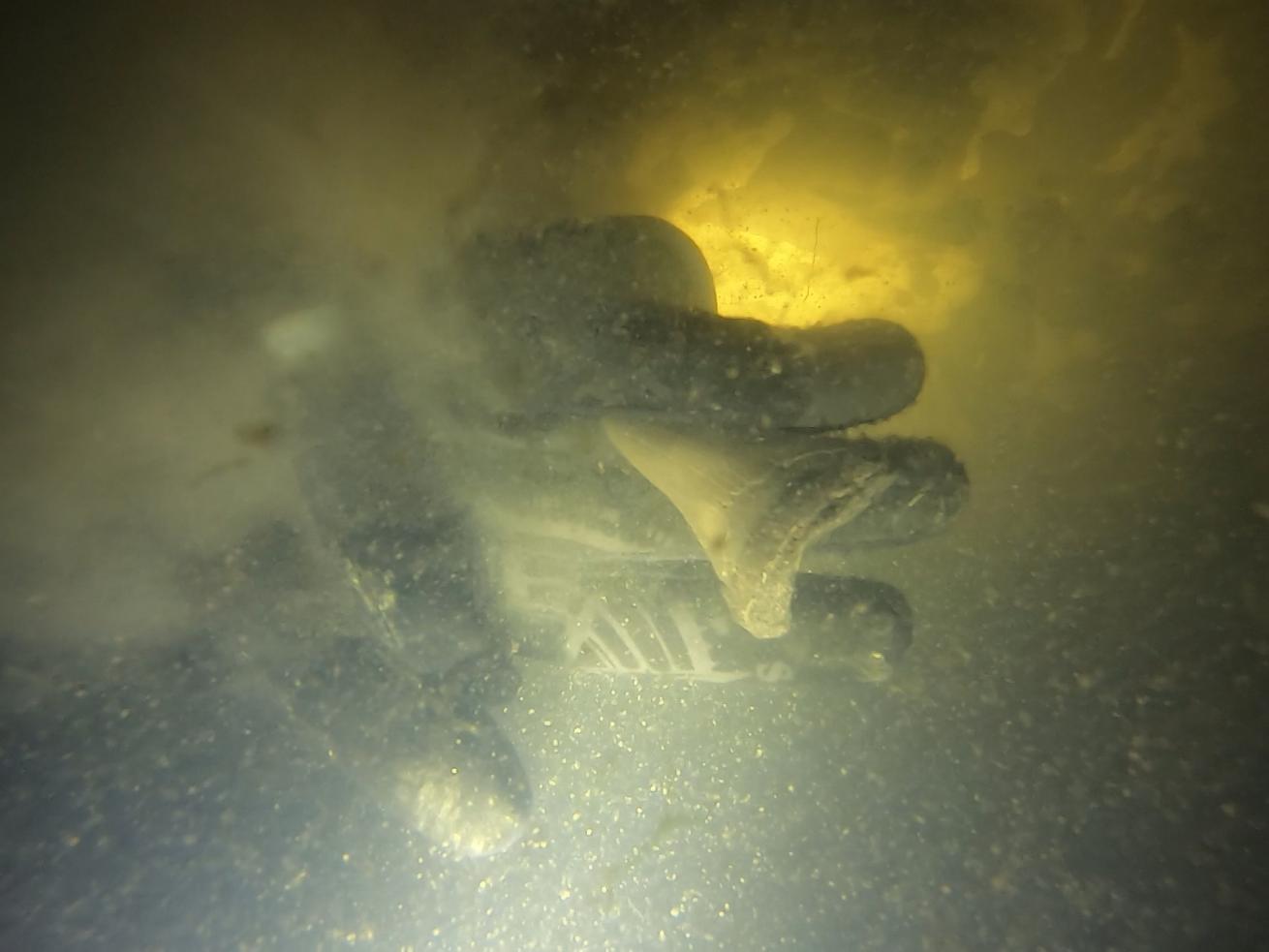
Courtesy Ischa VingleShark teeth and other fossils and artifacts sit on the riverbed of the Cooper River, which has a typical bottom visibility of about one foot
From the surface, I realize that it’s very easy to get stuck in your head when you’re wandering through the darkness. It’s easy for fear to creep in and take over if you’re not focused on the task at hand.
When I get back into the water at the third site, I find the gravel bed and spend an hour exploring, meticulously searching for fossils. I find several small megalodon and angustidens shark teeth, part of an old clay pipe, clam steinkerns, fossilized corals and even some pottery that could date back to over 2,000 years ago.
Related Reading: How to Travel With a Blue Mind
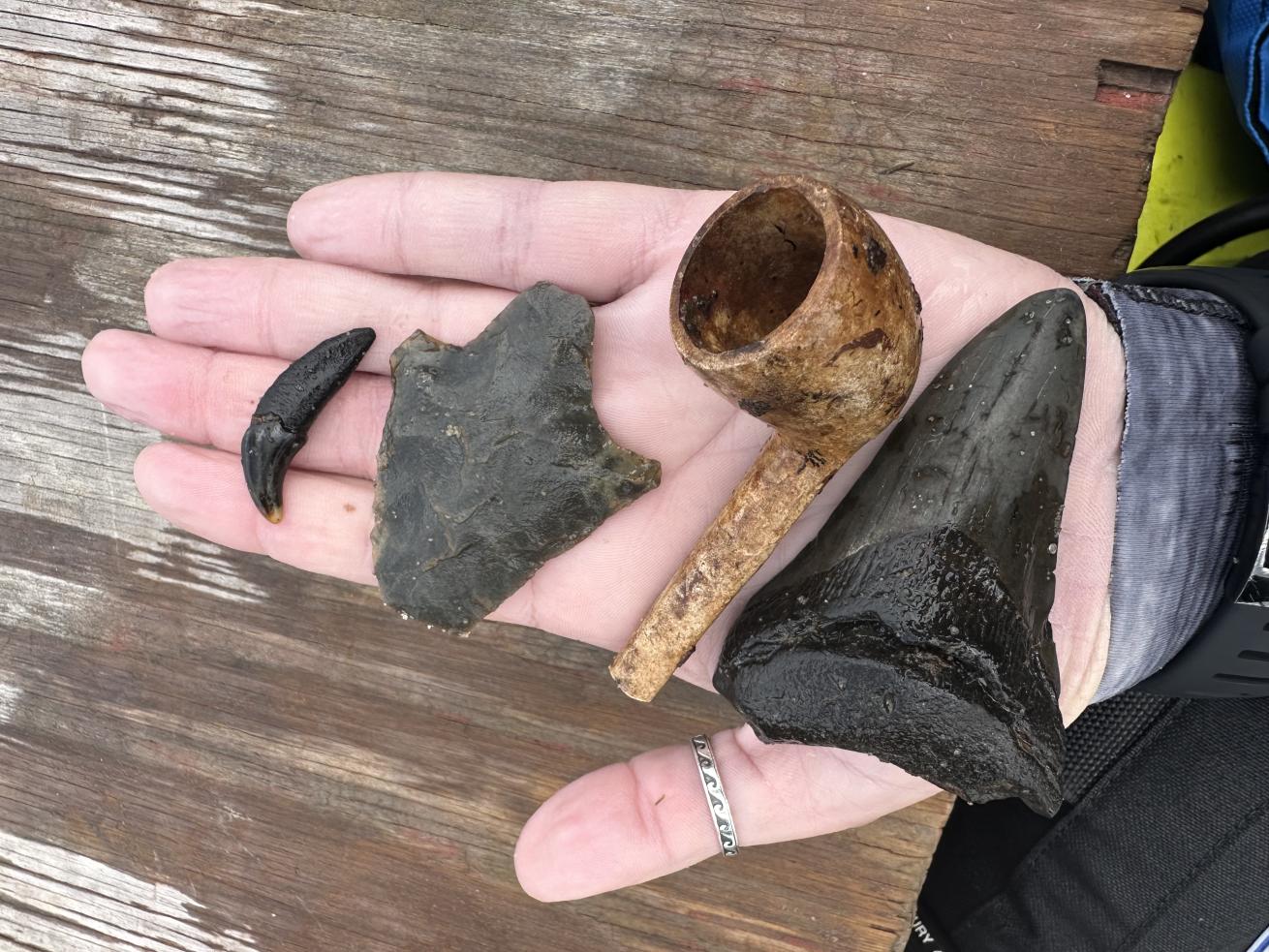
Courtesy Ischa VingleA shark tooth, clay pipe, speartip and claw
Ready For Next Year
I’m grateful to have experienced a whole new world of scuba diving and to have a few beautiful pieces of South Carolina Lowcountry history as keepsakes. This type of diving—like all diving—takes practice, and I look forward to getting back out there. Now I know to bring bigger lights when fossil hunting in these murky waters, but I’ll have more experience with blackwater diving under my belt, and better knowledge of how to find and identify shark teeth.
Thank you Ischa from Mountains to Seas Adventures for inviting me, and thank you Mark of www.divethecooper.com for the charter and local knowledge.
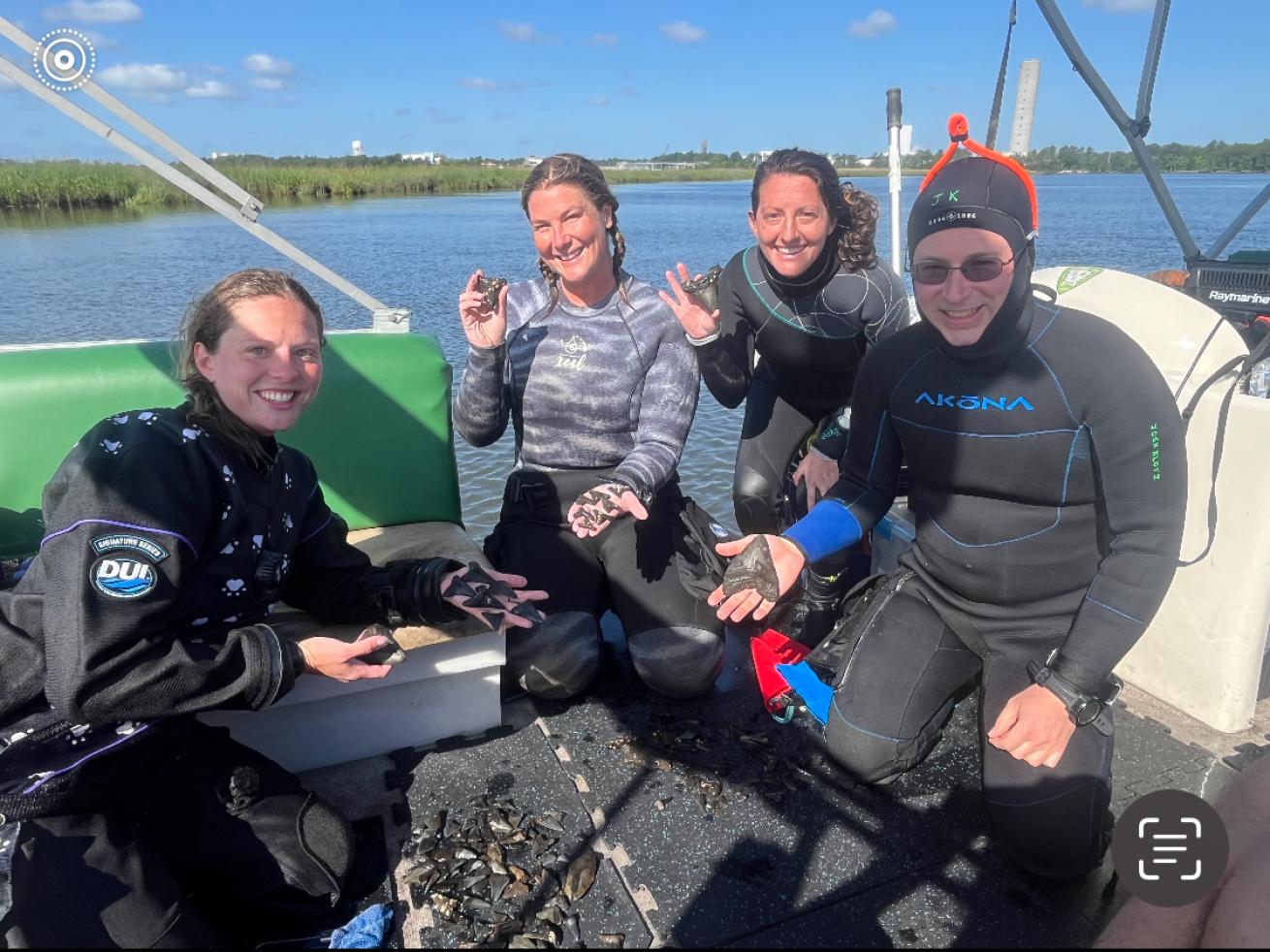
Courtesy Ischa VingleSome of the divers pose with their fossil finds aboard Captain Mark’s boat.
Diving the Cooper River FAQs
1. Do I need any specialty dive certifications?
Diving the Cooper River offers a unique and challenging experience, but due to the strong currents and dark conditions, it is not for the faint of heart. Divers should have at least an advanced certification, as well as experience with underwater navigation and diving in a range of conditions. Other useful PADI certifications that are recommended include rescue diver, self-reliant diver and night diver. The cyprus tannin-stained water can be very dark and the current can be strong here. Depths range from 15-50 feet in the river, though the average depth at most dive sites is around 23-40 feet. Visibility can range from 1 to 12 feet in the water column and 0 to 5 feet at bottom. In addition to having tanned water, the river carries a high level of sediment, which is why the visibility is typically less than 1 foot at the bottom.
2. Any tips for diving in the Cooper River?
1) Keep track of your bearings at all times. With so few references, it’s easy to become disoriented. You need to be comfortable with being in dark water. If you’re not used to blackwater diving, it’s a good idea to do some training dives first.
2) Bring powerful lighting. A wrist lamp and a headlamp are necessary. It’s also a good idea to have a backup light just in case so you don’t get stuck in the dark if your main light goes out.
3) Use a dive spike or large screwdriver tool for stabilization. The current can be very strong at times throughout these waters, so it is recommended to have a tool to keep attached to your wrist to anchor yourself as needed.
4) Bring a collection bag. You’ll need somewhere to safely keep your treasures.
3. Do I need a permit to collect fossils and artifacts in the Cooper River?
Yes. In order to collect fossils and historical artifacts while sport diving in the state of South Carolina, a Hobby License from the state’s Maritime Research Division is required, and only surface collecting is permitted (no digging or excavating).
4. What kind of fossils and artifacts can I find in the Cooper River?
South Carolina’s Lowcountry has been inhabited by humans for over 10,000 years. It’s possible to find arrowheads, spear points, pottery shards, and other remnants of Indigenous history, as well as colonial artifacts. This river cuts through layers of fossil-bearing formations from the Pleistocene, Oligocene, Pliocene, and Miocene, and the fossils erode out of the layers in the banks over time and continue to accumulate in gravel beds on the bottom of the river. This includes a variety of fossilized shark teeth, stingray plates, clams, coral, bones, and more.
5. Are there local dive charters to take me out on the Cooper River?
Yes, there are local charter operators (such as Captain Mark) who take divers out to known dive sites along the Cooper River. Unless you are a local with a suitable boat and experience on these waters, it is necessary to work with one of the charter captains who serve the trade in this area.
6. What type of wildlife could I see?
The river is home to an abundance of wildlife. It is common to see ospreys, egrets, dolphins, catfish, blue crab, and occasionally alligators. There are also many tiny crabs and shrimp living among the rubble piles on the riverbed, so tread lightly on the bottom while searching.


